Care too post some own cooked german designs that really would’ve been useful?
Here’s my 50mm on Luchs.
Actually I find the gaerman military had no decent light tank, only test vehicles and obsolete types.

Care too post some own cooked german designs that really would’ve been useful?
Here’s my 50mm on Luchs.
Actually I find the gaerman military had no decent light tank, only test vehicles and obsolete types.
thats cool.
that never crossed my mind and is vary true. The Germans had big tanks and old little ones that couldn’t fight tank to tank.
good call and your drawing looks sweet!
Panzer I D VK 602 Project with sloping armor.
The Germans did build some without slope in 1942. Speed +75km/h (+50mph) !!!
Original:
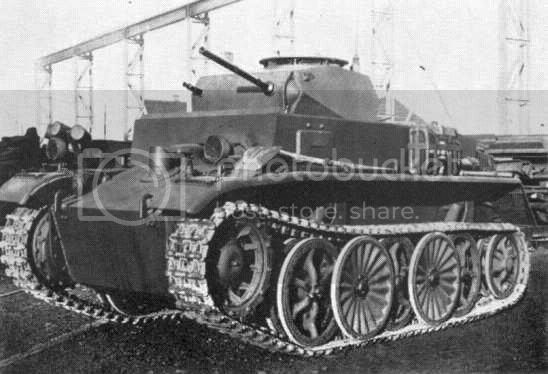
I widened the tracks and added sloped armor. Original weight = 8 tons / 150 hp engine. adding the sloped armor can make it 9 tons, which would surely still give 70 km/h.
In photoedit it looks this way:

I repeat: this again proves the germans could have made more easy-to-build light tanks in large numbers even in 1942 which would have filled up the gaps more easy along with a medium III/IV hybrid, but they rather choose to develop the Tiger…
Sorry, but I’m quite fond of it. I wonder how I could make a model of it…
The same modeled from the picture from [b]Achtung Panzer[/b]:

Thats largely because the Germans realised that ‘this years’ medium tank model would likely fill the ‘recon tank’ role a year or two later…atleast in the panzer regiments it seemed to work that way. As there numbers were allowed to run down, this became a natural fit.
I guess it partially went that way. AFAIK the Panther tank, which is considered mediumheavy rather than medium, was used more often as recon tank than forseen. This illustrates not the fantastic design of the Panther, yet the shortage of useful light and not at least speedy tanks.
And light tanks use a lot less fuel. Needless to say that - especially regarding fuel shortage - recon missions should be cheaper than battles.
Looking at the development of the Tiger, I can hardly think of it as a logical choice regarding future recon missions. It was designed as a heavy monster and used as such.
When designing a tank one must always consider what it is used for and in the case of the germans, when during the war would the tank be produced. At the start of the war, the Germans used blitzkreig and therefore needed a high performance tank that could traverse large terrain without guzzling fuel and easy to maintain. During the end of the war, the Germans required a tank which were like armoured pillboxes and could destroy the rushing tanks. No attention would be placed on the mobility and such but rather on its firepower and armour.
Mobility was always an important treat with German designs. I guess we have to differ between the words mechanical reliability and mobility layout. All German tanks of over 40to had at least a 6-7 gear gearbox and a good mobility layout which enabled them to used the best engine rpm spectrum according to the terrain difficulty. Not so with Allied designs. Except the T-34 all other Allied tanks had far bader HP/weight ratio with gear boxes with rougher grading of 3-4 gears.
Well again, it was a wrong choice then.  The Germans did not require pillboxes, they thought they did. Finally, you get pillboxes that are ten times as expensive and difficult to maintain then stick concrete ones. I beg to differ… I chose two light tanks AND a pillbox, rather than a Hunting Tiger…
The Germans did not require pillboxes, they thought they did. Finally, you get pillboxes that are ten times as expensive and difficult to maintain then stick concrete ones. I beg to differ… I chose two light tanks AND a pillbox, rather than a Hunting Tiger…
True but I would not have considered the Tiger as a medium tank anyway. The idea was that making best use of old otherwize obsolete tanks already built. The best idea in production is to have as few chassie as possible in production. This facilitiates faster less wastefull and more cost effective production. So any small production run of anything is going to be undesireable.
Now if your proposed recon tank chassie is also used as the basis of a Sp howitzer or Panzer Jagger and maybe even some kind of Sp flak and APC, then a large enough production run can be justified to allow it to be adapted to any specific roles including a recon tank. But this should be primarily for the Recon battalions.
As was … the Tiger.  I read somewhere 2 Panthers could be made with the resources used for 1 Tiger… It is really questionable why the Tiger still was in production as mate as mid 1944.
I read somewhere 2 Panthers could be made with the resources used for 1 Tiger… It is really questionable why the Tiger still was in production as mate as mid 1944.
Now if your proposed recon tank chassie is also used as the basis of a Sp howitzer or Panzer Jagger and maybe even some kind of Sp flak and APC, then a large enough production run can be justified to allow it to be adapted to any specific roles including a recon tank. But this should be primarily for the Recon battalions.
All chassis was designed as tank turret carrier. In the event they all were tested and converted. I wouldn’t have made a design based on the principles of a howitzer, flak or AT carrier.


Well, here i go … 
The tankhunter would be the 50/L60 gun I guess, a 75mm wouldn’t have fit, but I’m not sure, since the Hetzer was small too and had a 75 gun.
Second is a 150mm gun carrier.
Here are 2 Panther spin-offs for recco duties.

NO argument about the tiger tank. I have always maintained that Panther inplace of all TigerI /II production would have been best choice for them.
. In the first year BMW-801 engine production, each 1 ton engine required 5 tons resources, while the 1944 production required only 2.5 tons resources for each 1 ton engine. So after 3-4 years of production and 20,000 units, the resources needed and cost were cut in half. Now when the BMW 801 engine was first put in production, the DB-600/601/605 had been in production for several years. Given the 0.6/0.7 ton engine mass, it probably required only 1.5tons resources for each DB engine in 1941.
So if the same resources labor etc that were applied to the BMW engine were instead applied to the DB engine, it should have been able to produce over three times as many engines [ ~ 60,000 engines] .
However tank design, breaks the tank down into chassie, superstructure and armament. The chassie applies to the hull and features the engine transmittion drive train transmittion and suspention and tracks. This is clearly most of the work of the tank construction. The turret ring only applies to the superstructure design.
When the Germans switched Panzer III production to StuG-III production, the change only resulted in a 10% reduction in cost and production, because most of the production was still the same. So one could have a standard hull and differing superstucture/armament combinations.
One for recon tank,
one for howitzer or PAK or Flak etc.
One for SPW .
Obviously one common feature of such a universal AFV, would have to feature a front mounted engine to make room in the back for the Howitzer/Pak configuration.
front engine would be indeed a drastic change and would have granted better protection of the crew (especially in urban fights)
When you look at the Hummel , Nashorns, Marder & Grill[Pz-38t and Pz-II] plus Wespe conversions for the Panzer 38t, II and IV: these all had center mounted engines [Panzer II had Front mounted engine].
I’ve not heard that this was overly complicated construction and the numbers of the panzer II & Czeh 38t tanks production seem to match before and after this transition.
Man! All of you guys have a great talent. Really nice artwork.
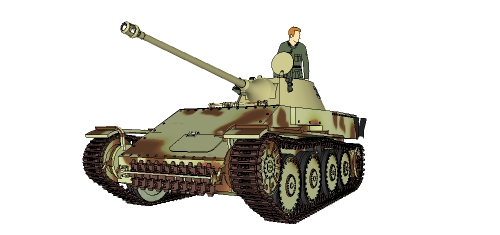
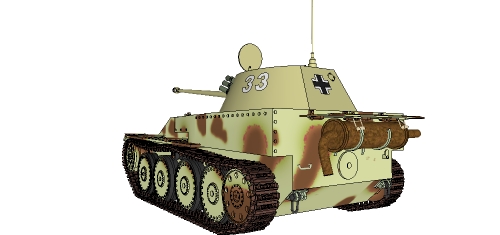
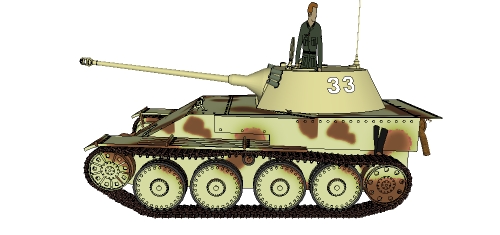
based on pz 38(t) chassis as in Marder series, but with rear mounted VK1602 turret (Leopard / Puma)
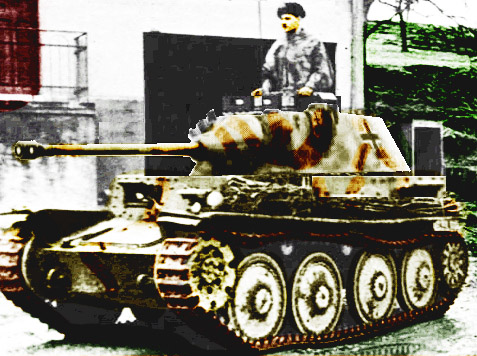
colourized collage
nice, very nice…